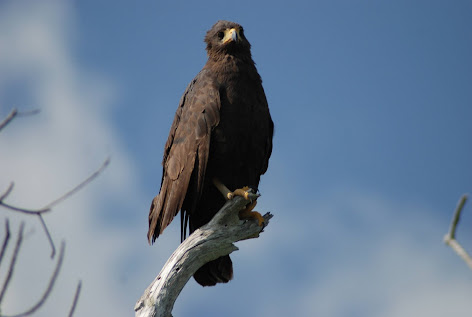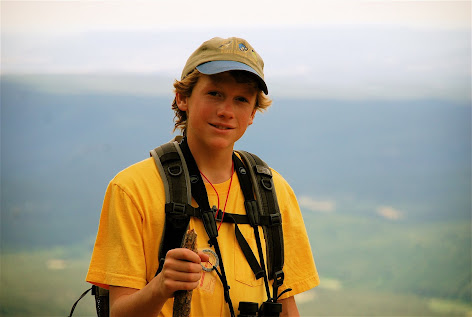I am terrible at identifying peeps and have been trying to distinguish those little buggers for the longest time and this weekend I finally had some progress in my identification of peeps.
 |
| Western Wood-Pewee at my house (nothing to do with peeps of course) |
Christopher Rustay came down to Las Vegas on Saturday and met me at the Las Vegas Detention Center (yep, I spent the night in jail...just kidding) and I also got to meet a young birder from Santa Fe, along with his dad. Raymond and Bill (two birders from Albuquerque who I've birded with a bunch in the past couple years) also came down. We started by going to the Las Vegas NWR and birding a row of trees before the entrance to the refuge. It wasn't too productive but we saw a couple Wilson's Warblers, a Red-naped Sapsucker, and some MacGillavray's Warblers. After birding the stretch of trees for 20 minutes, we drove to the Headquarters. There are a row of trees near the road that can be good during migration in front of the HQ building. We walked along this and found a resting Barn Owl and a Cooper's Hawk (that was mobbing the Barn Owl). We also saw a Willow Flycatcher (my first for New Mexico) and heard 2 Upland Sandpipers.
The next stop was Crane Lake, just a 3 minute drive from Headquarters. We scoped the lake and found 2 American White Pelicans, 50+ Cinnamon Teal, 2 White-faced Ibis, and Peregrine AND Prairie Falcon. The Peregrine was on a big dead tree besides the lake and while we were looking at it a Prairie flew over our heads! There were also a couple peeps on the mud surrounding the lake. My first thought was "
oh crap, what are these?" Luckily, I was with 5 birders who had a much larger knowledge of peep identification than I did. They showed me a group of peeps with tan throats and scalloped backs and pronounced them to be Baird's Sandpipers. I was very excited to finally find out what those "tiny things with tan throats" were and was feeling a bit more confident. Unfortunately, that was only one species and I have much more to learn before I master peeps. I was certainly a big help though. Thanks guys!
On McAlister Lake, there was another group of Baird's Sandpipers with about 850 Wilson's Phalaropes swimming on the lake! I had never seen that many phalaropes before-you could probably have walked across the lake on them! Besides the concentration of phalaropes, there wasn't much around or on the lake. We saw a Long-billed Curlew fly over and saw some more Willow Flycatchers but that was about it.
After birding the refuge for 3 hours, we headed out and drove to Springer Lake (about 1 hour north from Las Vegas). Talk about shorebirds! On the nearest side of the lake to the road there was barely anything but when we walked to the other side, there was a huge flock of mixed peeps, dowitchers, yellowlegs, plovers, and phalaropes. I got very excited at the sight of so many peeps and we decided to walk out on the mudflat a bit. We got pretty great views of Baird's, Western, and one Semipalmated Sandpiper along with some Lesser Yellowlegs, Wilson's Phalaropes, and Long-billed Dowitchers. The best bird was a lone juvenile Short-billed Dowitcher that Raymond picked out from a flock of Long-billeds. We were all hyped by this discovery (especially Christopher) and each of us got great looks at the bird in our scopes. Raymond tried to walk closer to the bird with his camera to take a picture and I decided to follow him. This was probably a mistake. As we walked farther towards the lake, it got harder to not sink into the mud. Raymond was a pro at keeping his shoes clean (and with a scope and camera) but I was pretty much a failure. I failed to learn that you have to walk with a broad stance and with light footsteps and consequently sunk knee-deep in the mud with my clumsy footsteps. I watched Raymond's many attempts at digiscoping the Short-billed Dowticher-which he eventually did get a great picture of-and tried not to say anything as my legs slowly oozed deeper into the mud. When Ray finally got a suitable picture of the bird, he turned to me and was surprised to see that I was now 2 feet shorter than him. He shook his head and laughed and helped me get out of my predicament by having me hold onto the scope and his hand. I eventually got out (after much tugging and squelching) and tramped back to the car with my shoes looking like they had just been stuck down a mud hole...never mind, that actually happened! I tried to remove as much of the mud as I could but I was still covered up to my knees for the rest of the day.
With me covered in mud, we stopped at a Subway to eat lunch and for me to try and clean up some more. I probably used Subway's entire stock of paper towels and still looked like crap. Oh well. Lunch was a relief though-nothing like eating Subway after half-sinking yourself in a mudflat!
We stopped at Maxwell NWR after lunch and I saw my life Dickcissel! We were near the entrance and saw a bird fly across the road and land on a fence and were very surprised to find out it was a Dickcissel (or DICK in its 4-letter code). It also happened to be #650 on my life list! Besides the DICK, we didn't see much (a couple American Avocets and a Peregrine Falcon were the exception).
The last stop of the day was Stubblefield Lake. It is just a short drive from Maxwell and can be very good for shorebirds sometimes. Unfortunately, there were very little shorebirds or waterfowl. Christopher did find a Common Loon as we were leaving, which is a pretty good bird for northern New Mexico.
Overall, it was a very fun and productive day and we ended up seeing 74 species. Below is the species list for the day:
Canada Goose -- 50
Mallard -- 1
Cinnamon Teal -- 80
Northern Shoveler -- 10
Green-winged Teal -- 20
Ruddy Duck -- 200
Common Loon -- 1
Eared Grebe -- 7
Clark's Grebe -- 2
Double-crested Cormorant -- 14
American White Pelican -- 3
Great Blue Heron -- 10
White-faced Ibis -- 16
Turkey Vulture -- 7
Northern Harrier -- 1
Cooper's Hawk -- 1
Swainson's Hawk -- 5
Red-tailed Hawk -- 1
Peregrine Falcon -- 1
Prairie Falcon -- 1
American Coot -- 50
Semipalmated Plover -- 2
Killdeer -- 10
American Avocet -- 5
Spotted Sandpiper -- 4
Solitary Sandpiper -- 2
Lesser Yellowlegs -- 3
Upland Sandpiper -- 2
Long-billed Curlew -- 1
Semipalmated Sandpiper -- 1
Western Sandpiper -- 4
Baird's Sandpiper -- 200
Short-billed Dowitcher -- 1
Long-billed Dowitcher -- 4
Wilson's Phalarope -- 850
Ring-billed Gull -- 10
Forster's Tern -- 1
Rock Pigeon -- 1
Eurasian Collared-Dove -- 4
White-winged Dove -- 1
Mourning Dove -- 9
Barn Owl -- 1
Black-chinned Hummingbird -- 2
Red-naped Sapsucker -- 1
Western Wood-Pewee -- 3
Willow Flycatcher -- 4
Say's Phoebe -- 1
Cassin's Kingbird -- 1
Western Kingbird -- 5
Loggerhead Shrike -- 1
Common Raven -- 3
Horned Lark -- 15
Violet-green Swallow -- 5
Barn Swallow -- 5
Bewick's Wren -- 1
House Wren -- 1
Northern Mockingbird -- 1
European Starling -- 40
MacGillivray's Warbler -- 2
Yellow Warbler -- 10
Wilson's Warbler -- 2
Chipping Sparrow -- 4
Brewer's Sparrow -- 2
Vesper Sparrow -- 2
Lark Sparrow -- 3
Lark Bunting -- 1
Dickcissel -- 1
Red-winged Blackbird -- 18
Western Meadowlark -- 2
Yellow-headed Blackbird -- 4
Bullock's Oriole -- 1
Pine Siskin -- 7
Lesser Goldfinch -- 10
Unfortunately, I forgot a camera (again) and don't have any pictures. I'm going to start bringing a camera on all my birding trips so this doesn't happen again!






































